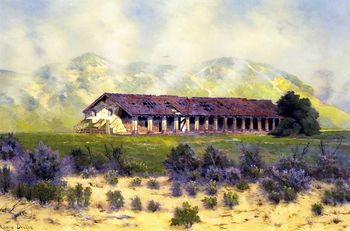Mission La Purísima Concepción
 Mission La Purísima Concepción, circa 1899.[1] Mission La Purísima Concepción, circa 1899.[1]
| |
| HISTORY | |
|---|---|
| Location: | Lompoc, California |
| Name as Founded: | La Misión de La Purísima Concepción de la Santísima Virgen María [2] |
| English Translation: | The Mission of the Immaculate Conception of the Most Blessed Virgin Mary |
| Patron Saint: | The Immaculate Conception of the Most Blessed Virgin Mary [3] |
| Nickname(s): | "The Linear Mission" [4] |
| Founding Date: | December 8, 1787 [5] |
| Founded By: | Father Fermín Lasuén [6] |
| Founding Order: | Eleventh [3] |
| Headquarters of the Alta California Mission System: | 1815–1819 [7] |
| Military District: | Second [8] |
| Native Tribe(s): Spanish Name(s): |
Chumash Purisimeño |
| Primordial Place Name(s): | Laxshakupi, 'Amuwu [9] |
| SPIRITUAL RESULTS | |
| Baptisms: | 3,255 [10] |
| Marriages: | 1,029 [10] |
| Burials: | 2,609 [10] |
| DISPOSITION | |
| Secularized: | 1834 [3] |
| Returned to the Church: | 1874 [11] |
| Caretaker: | California Department of Parks and Recreation |
| Current Use: | Museum |
| Coordinates: | 34°40′14″N, 120°25′14″W |
| National Historic Landmark: | #340 |
| Date added to the NRHP: | 1970 |
| California Historical Landmark: | #200 |
| Web Site: | http://www.lapurisimamission.org |
Mission La Purísima Concepción, the second mission site to bear the name, was founded on the "Feast Day of the Immaculate Conception of the Blessed Virgin" (December 8), 1787. The present site is located east of the City of Lompoc, California between Santa Barbara and San Luis Obispo. The City of Lompoc was so small that the Roman Catholic Church made an exception to the rule that no mission is to be established within seven miles from any city (the original site of La Purísima was only one mile from the tiny town). It was moved four miles east of the town in 1812 after the Santa Barbara Earthquake severely damaged the Mission buildings on December 21st of that year.
- Other missions bearing the name La Purísima Concepción include
Mission Puerto de Purísima Concepción near Yuma, Arizona,
Mission Nuestra Señora de la Purísima Concepción de Acuña in San Antonio, Texas,
Misión La Purísima Concepción de Cadegomó in Baja California Sur, and
Misión La Purísima Concepción de Caborca, in Caborca, Sonora, Mexico.
History
In 1824, there was a major Indian revolt at the Mission. Spain had stopped funding the missions after Mexico won its independence, and there were many soldiers at the Mission who were no longer being paid and took out their frustrations on the local Chumash Indians. A soldier had beat an Indian at Mission Santa Inés and a revolt spread to Mission La Purísima, where the Indians took over the Mission for one month until more soldiers arrived from Monterey; after a three-hour battle, the Indians lost. Many of the Indians left the Mission soon thereafter; those who did not fight and were hiding in the mountains during the revolt came back to the Mission, but there were not enough of them to keep the Mission going as it once had.
Following Mexican secularization in 1843, the grounds were abandoned; in 1934, only nine of the buildings remained. The Civilian Conservation Corps pledged to restore the Mission if enough land could given back to make the Mission into a historical monument. The Church and the Union Oil Company then donated enough land for the restoration. The buildings were all reinforced and reconstructed (including many small structures and the original water system) to such an extent that La Purísima is considered to be the only example in California of a "complete" mission complex. The dedication day for the newly-restored Mission La Purísima Concepción was December 7, 1941.
Other designations
- National Register of Historic Places #NPS-78000775 — original Mission La Purísima Concepción site
- California Historical Landmark #928 — original Mission La Purísima Concepción site
- ↑ (PD) Painting: Edwin Deakin
- ↑ Leffingwell, p. 79
- ↑ 3.0 3.1 3.2 Krell, p. 202
- ↑ Ruscin, p. 97
- ↑ Yenne, p. 104
- ↑ Ruscin, p. 196
- ↑ Yenne, p. 186
- ↑ Forbes, p. 202
- ↑ Ruscin, p. 195
- ↑ 10.0 10.1 10.2 Krell, p. 315: as of December 31, 1832; information adapted from Engelhardt's Missions and Missionaries of California.
- ↑ Krell, p. 202: The property was subsequently sold in 1874 due to its dilapidated state, and acquired by the State of California in 1935.